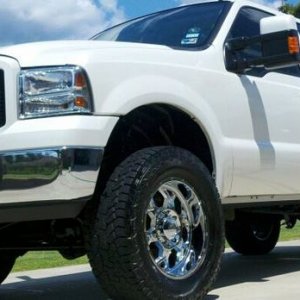Charles
Well-known member
- Joined
- May 18, 2011
- Messages
- 2,729
- Reaction score
- 47
A centrifugal compressor likes to move more volume flow as it produces greater pressure. If the pressure continues to increase without sufficient gains to volume flow across the wheel, such as what happens as rpm is held relatively constant and boost keeps increasing, at some point the wheel is going to lose it's grip on the air, and "slip" if you will. When this happens the flow becomes unstable kind of like gears jumping teeth, the blades loose the air momentarily. When this happens the pressure momentarily drops dramatically, allowing the wheel to regain "traction" if you will, where it nearly immediately catches and throws the pressure too high, where it loses traction and slips again, and again, and again until either the volume flow increases (engine rpm comes up) or boost decreases (you lift out of the throttle to some degree).
If you look at a compressor map the surge line is the far left line plotted up that side. Anything to the left of this line represents combinations of pressure and flow where the flow is too little and the pressure to much for the compressor to remain stable. It will start to chop and miss if asked to run there.
What a ported compressor housing does is specifically to bleed air midway down the wheel back into the compressor inlet, allowing the wheel to run a portion of the air round and round in circles right back to itself. This allows the flow across the wheel to come up. And even though it's not actually going into the engine or even out of the turbocharger, the wheel doesn't care, it still gets to move more CFM which allows it to remain stable at higher pressures for any given discharge CFM.
The Wicked wheel simply flows less CFM in its wheel design, and due to a less aggressive blade style it is more stable at lower flow rates at the cost of top end performance. Just like you can pick cam profiles that work better at certain engine rpm, you can select compressor wheels of the same diameter that work different at varying flow rates and pressure ratios. The wicked wheel is likely more suited to lower ultimate pressure ratio usage but has a broader stability region in terms of flow. The late model OEM wheel is probably a bit more efficient at higher boost and higher flow rates at the cost of low rpm compressor stability, which we see as surge when we ask for too much boost down low.
If you look at a compressor map the surge line is the far left line plotted up that side. Anything to the left of this line represents combinations of pressure and flow where the flow is too little and the pressure to much for the compressor to remain stable. It will start to chop and miss if asked to run there.
What a ported compressor housing does is specifically to bleed air midway down the wheel back into the compressor inlet, allowing the wheel to run a portion of the air round and round in circles right back to itself. This allows the flow across the wheel to come up. And even though it's not actually going into the engine or even out of the turbocharger, the wheel doesn't care, it still gets to move more CFM which allows it to remain stable at higher pressures for any given discharge CFM.
The Wicked wheel simply flows less CFM in its wheel design, and due to a less aggressive blade style it is more stable at lower flow rates at the cost of top end performance. Just like you can pick cam profiles that work better at certain engine rpm, you can select compressor wheels of the same diameter that work different at varying flow rates and pressure ratios. The wicked wheel is likely more suited to lower ultimate pressure ratio usage but has a broader stability region in terms of flow. The late model OEM wheel is probably a bit more efficient at higher boost and higher flow rates at the cost of low rpm compressor stability, which we see as surge when we ask for too much boost down low.












